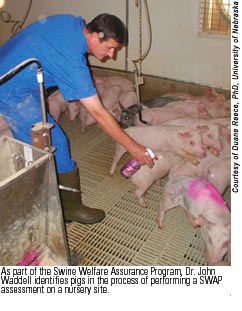Indulging his passion for pigs
|
Toward the top of Dr. John Waddell's presidential list of AASV priorities for the coming year is working with veterinary colleges to recruit and retain students for food supply veterinary medicine.  During the AASV meeting in Des Moines, Dr. Waddell noted that the board of directors had just showed how important that issue is by voting to contribute $40,000 toward a supply/demand and recruitment/retention study being supported by the profession and industry (see page 1401). He believes that the report will give deans science-based justification for increasing recruitment and retention efforts in that area. Even now, some colleges have initiatives under way. Another encouraging development came in December, when President Bush signed the National Veterinary Medical Services Act, which authorizes the Department of Agriculture to provide student loan repayments to recent veterinary graduates who agree to work in underserved areas of the country. "The AVMA has been a major player in bringing the species groups and the right people to the table to help design (the implementing regulations) in a way that's going to benefit food supply veterinarians the most," Dr. Waddell said. For all his 23 years in practice, Dr. Waddell has been with Sutton Veterinary Clinic in Sutton, Neb., a high-volume food animal practice where he practices swine medicine. Sutton is only about 10 miles from Clay Center, Neb., where the Meat Animal Research Center and Great Plains Veterinary Teaching Hospital are located. Food supply veterinary students rotate there from a consortium of veterinary colleges. Those interested in visiting a nearby private practice are often directed to Sutton. Some serve formal university preceptorships at Sutton; other visits are less structured. Students have come from most U.S. veterinary colleges as well as Denmark, Germany, Portugal, and Asia. Dr. Waddell is inspired to mentor students the way veterinarians such as Ralph Vinson and Leroy Biehl did with him. "I'm just passing it on and providing those kids with an opportunity to see real-world food animal medicine," he said. "I run into a lot of them in our association who become lifelong swine practitioners." It was natural that Dr. Waddell himself aspire to a career in food supply veterinary medicine, raised on a grain and livestock farm in central Illinois. His interest then was beef cattle. That changed one summer during undergraduate school when he worked on a large pig farm in Illinois. "They were early adapters of technology, and I was enthralled with the production portion of it—the numbers and how they managed the flow of the farm," he recalls. Enrolled in the class of '81 at the University of Illinois College of Veterinary Medicine, Dr. Waddell and a few classmates of like mind would occasionally cut class for field trips. "If it came down to a histology lecture or a road trip to look at a new pig farm, we would go look at the pig farm," he says. "I always had a few willing accomplices in my class—Tom Painter, Charlie Schelkopf, and Brad Shive, who went on to become swine veterinarians." The truants would line up a new breeding barn or a practitioner who was doing something innovative with pigs. Two years out of veterinary college, he began volunteering with the AASV, eventually chairing the Public Relations and Pharmaceutical Issues committees and serving on the board of directors. Dr. Waddell has also chaired the Food and Drug Administration's Veterinary Medicine Advisory Committee, and the AVMA Steering Committee on Antimicrobial Resistance. Bringing science into focus on the antimicrobial issue has been an uplifting experience for him. "It makes you feel good you changed the tide toward what's right," he said. Influencing more members of the AASV to become involved in their organization is Dr. Waddell's top priority. He also favors a review of the AASV committee structure to create "some new synergy that will help us jump-start into the next year." Member retention has been a problem. The biggest decline was in 1999, following plummeting hog prices. Annual declines since then appear to be slowing. Dr. Waddell said that increased membership from Canada, Mexico, and Europe have offset the loss of members from traditional pork production areas. Less than a month after the AASV meeting, the AVMA Executive Board was to appoint members to the Task Force on the Housing of Pregnant Sows, to thoroughly review scientific evidence and recommend an AVMA position on pregnant sow housing. "AVMA is doing the right thing by bringing all concerned parties to the table," Dr. Waddell said. "I believe that when all the science on the issue is compiled, there will be a positive outcome for all involved—including the sows." | ||